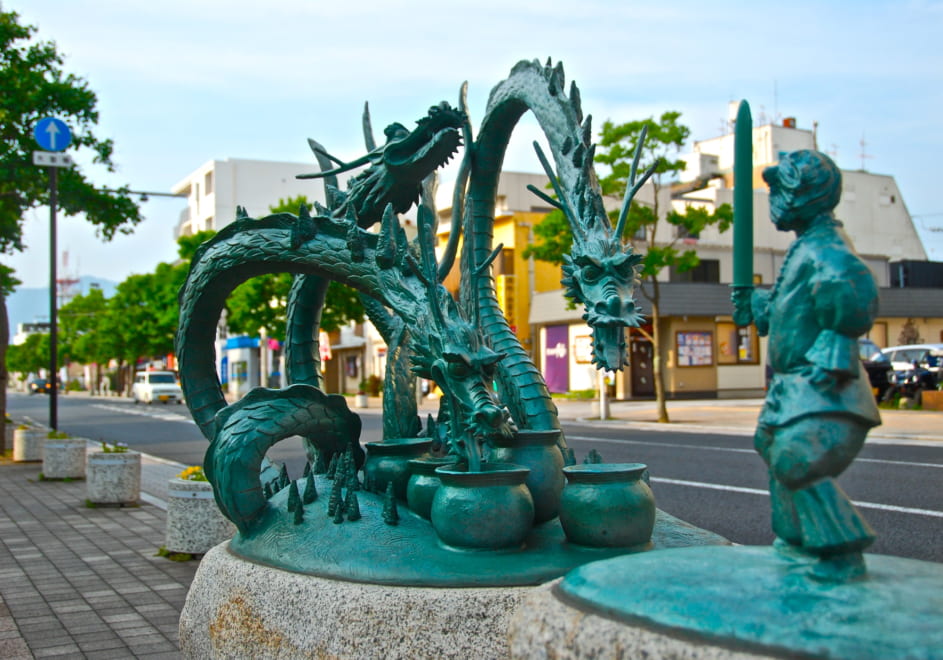Yamata-no-Orochi-The Eight-headed, Eight-tailed Serpent
Exploring the Kojiki
Updated on Jan 21 2020

A statue of Susa-no-O and Yamata-no-Orochi(Izumoshi Station)
The Yamata-no-Orochi is perhaps the most frightening of all Japan’s many mythological monsters. According to the Kojiki, this fearsome serpent had eight heads and eight tails, with a body large enough to span eight valleys and a surface of such magnitude that moss and Japanese cedar trees grew upon it. The beast’s belly is said to have been covered in bloody red sores, while its eyes had the appearance of Chinese lantern plants.
Even the name of the beast is strange and mysterious. “Yamata” means “eight forks,” referring to the type of branching fork found in a tree or a road. Yet with its neck forking forwards, as it is often depicted, eight forks should mean that the monster has at least nine heads. Could it be that the beast was originally conceived of as looking something like a giant sea anemone, with its many heads wriggling outwards from around the mass of its body? Since “Ya,” which means “eight,” can also mean “a large number,” the Yamata-no-Orochi might have been a serpent with many necks. With its combination of a terrifying appearance, vast proportions, and cryptic details, the appearance of the monster is perfectly keyed to excite the imagination.
The Yamata-no-Orochi is said to have visited Izumo Province (located in present-day Shimane Prefecture) every year to devour young girls. One year, it fell to Kushi-nada-hime to be sacrificed, the last of eight daughters whose sisters had all died in the same way before her. However, on hearing of the girl’s plight, deity Susa-no-O offered to kill the Orochi in exchange for Kushi-nada-hime’s hand in marriage.
In preparation for his fight with the great serpent, Susa-no-O had extremely strong sake prepared and poured into eight jars. When the Orochi arrived, it thrust its head into each jar and drank up all of the sake. The drunken Orochi soon fell asleep. Seeing his chance, Susa-no-O attacked the creature, tearing and cutting it to pieces, and ultimately sending it to its death.
After Susa-no-O had slain the Orochi, he noticed a magnificent sword appear from the tail of the beast. Susa-no-O took the blade and offered it to Amaterasu in Heaven. This sword was the Ame-no-Murakumo-no-Tsurugi, which would later be known as the Kusanagi-no-Tsurugi, one of the three sacred treasures of the Imperial Regalia of Japan.
In this way, Susa-no-O defeated the Orochi, married Kushi-nada-hime, and settled down to live in Izumo.
Snakes and serpents have been viewed as divinities associated with water for millennia and across many cultures. As the Yamata-no-Orochi has been seen as representing the Hii River in Shimane Prefecture, the appearance and eventual salvation in this myth of Kushi-nada-hime, who could be considered the goddess of rice fields, suggests that the tale might be interpreted as one that relates to protecting rice fields from floods brought on by water deities. The myth has also been seen as relating to the Iron Age, with the blood-red belly of the Orochi recalling the flames of iron production and the miraculous creation of a sword from the beast’s tail signifying the birth of iron weaponry.
One of the myths of the Hittites, the oldest Iron Age culture in the world, also speaks of a serpent, called Illuyanka, and its killing by the hero Hupasiyas. According to this story, Hupasiyas held a great feast in order to trick Illuyanka into appearing from a hole in the ground. Hupasiyas gave the serpent a large amount of food and wine and then attacked and killed the beast once it had grown too fat to escape back through its hole. This ancient myth shares much in common with the tale of the Orochi, with both creatures meeting a violent end at the hands of cunning heroes who use the bounty of the land to defeat them.
The tale of the Orochi also mirrors in part the famous Greek myth of Perseus and Andromeda, in which a hero fights and defeats a great beast in order to save, and later marry, a woman given up as a sacrifice. This is a common theme in many heroic tales from around the world and lives on today in stories of damsels being rescued from dragons by princes.
The myth of Yamata-no-Orochi carries with it a wide variety of themes, some specific to Japanese culture and others with a more universal resonance. This tale reflects the human fascination with the meeting of land and water, and even the common heritage of Eastern and Western civilizations. There are, we might say, as many branches to this story as the dragon has heads.
Kikuko HIRAFUJI
Research
Mythology, Religious Study, History of Religion
Papers
Deities in the interwar period(2023/09/08)
Translation Issues in Kojiki: God, Deity, or Spirit?(2016/01/01)

